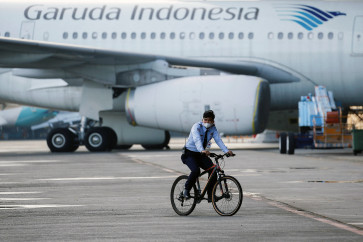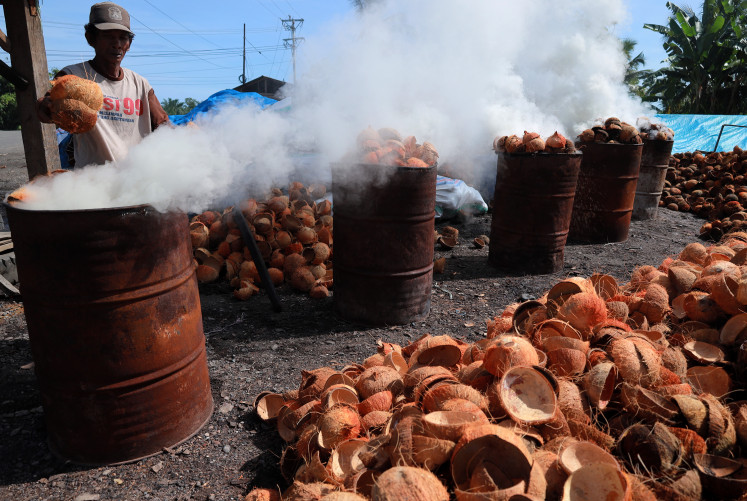ANALYSIS: A glimpse of hope in the heavy-equipment industry
Pressure on the heavy equipment industry still lingers
Change text size
Gift Premium Articles
to Anyone

P
ressure on the heavy equipment industry still lingers. The plummeting demand for heavy equipment has resulted in a steep decrease in sales. In the first quarter of 2016, sales in almost in all sectors recorded negative growth with the exception of the construction sector .
The decrease in demand is indicated by the sales performance of United Tractors, one of the biggest heavy-equipment players. As of March 2016, United Tractors, carrying Komatsu products, is the market share leader in the domestic market of heavy equipment with 34 percent, followed by Hitachi (20 percent), Caterpillar (16 percent), Kobelco (15 percent) and other brands (15 percent). From January to March 2016, Komatsu sold only 499 units, a 35 percent decrease from the same period of last year, which saw the sale of 763 units. The largest degree of negative growth took place in the forestry and mining sectors, suffering a 58 percent and 59 percent decrease, respectively.
We think that the mining sector will not improve in the near future. The low coal price is responsible for low coal production, and that in turn has affected the need for heavy equipment. This is reflected by decreasing sales of heavy equipment in the mining sector, from 33 percent as of January-March 2015 to 21 percent as of January-March in 2016. In the forestry sector, the sales also dropped, from 25 percent as of January-March 2015 to 16 percent as of January-March 2016.
The plantation sector was still suffering from low demand in 2015 but with the rebound of the crude palm oil (CPO) price, we predict that the sales performance in this sector will continuously improve. The data shows an increase in sales from the plantation sector of approximately 15 percent as of January-March 2016, from 12 percent in the same period the year before.
The data also shows that sales in the construction sector rose from 30 percent as of January-March 2015 to 48 percent as of January-March 2016. In the last few years, demand for heavy equipment in the construction sector has increased as the government’s infrastructure projects have started to kick in. We predict that this trend in the construction sector can be maintained.
We expect that the increase in the CPO price will promote the demand for heavy equipment in the plantation sector. Apart from the plantation sector, the government’s 2016 infrastructure projects are also expected to increase demand in the construction sector. Shifts in heavy-equipment demand from the mining sector to the construction and plantation sectors has also resulted in shifts in demand for excavators and bulldozers.
One critical factor that may still threaten the heavy equipment industry is the mining sector suffering even more due to the low price of coal that has consequently caused lower production. Still dominating demand for heavy equipment, this sector is the reason behind the slump in the heavy equipment industry.
In addition to that is the extreme weather that may threaten plantations. El Niño, expected in the dry season to the end of 2016, is a threat to the demand for heavy equipment in the plantation sector. Another important factor is the high import content, which is as much as 60 percent, in heavy equipment. Fluctuating exchange rates and the depreciated rupiah have a significant impact on imports and sales and the impact of the exchange rate will be felt in the quarters ahead.
According to law passed in 2009, heavy equipment is classified as a motor vehicle, which means that an owner of such equipment has the same obligation as that of the owner of a motor vehicle in vehicle tax, type tests and transfer tax. When classified as a motor vehicle, heavy equipment is barred from being modified by the law and this has put heavy equipment users in a difficult position as they have to customize the capability and dimension of the equipment according to the characteristics of a site or the location of a factory, mine or plantation.
With the issuance of a related decree in 2015, imposed since March 31 of this year, heavy equipment is now categorized as a non-motor vehicle. Various businesses in construction, plantations, and ports using heavy equipment are now relieved from the many taxes generally imposed on motor vehicles. Hope also arises from heavy equipment manufacturers. Jamaludin, chairman of the Association of Indonesian Industrial Heavy Equipment (Hinabi), has welcomed the decree and hopes that it will relieve consumers in Indonesia and drive demand.
The global economic slowdown has resulted in low demand in sectors with heavy equipment, weakening sales performance and decreasing company income. However, some companies have diversified their business strategies by moving into spare parts. This diversification is useful to compensate for decreases in heavy equipment sales to the mining sector. At the moment, sales of spare parts have helped to add to company revenues.
Furthermore, efficiency is also an important factor in a company’s performance. To handle decreasing sales, companies take efficiency measures to lower production expenses.
We predict that business opportunities in the heavy equipment industry in 2016 will be slighty better than 2015, for two reasons. First, there will be higher demand from the plantation sector, in particular palm oil plantations, where the CPO price will significantly rebound from US$620 to $640 per ton. To date, the CPO price has increased by 30 percent. Though this condition does not immediately affect demand for heavy equipment, it can serve as good news for the heavy equipment industry.
Second, the infrastructure projects intiated by the government will add new demand for heavy equipment. This is indicated by first quarter data, which reveals that only demand from the construction sector recorded positive growth. We are convinced that this will be an important driver for the heavy equipment industry because the government builds a lot of infrastructure projects. In 2016 the government plans to spend Rp 313.5 trillion on infrastructure projects.
_____________
The writer is an industry analyst at Bank Mandiri
---------------
To receive comprehensive and earlier access to The Jakarta Post print edition, please subscribe to our epaper through iOS' iTunes, Android's Google Play, Blackberry World or Microsoft's Windows Store. Subscription includes free daily editions of The Nation, The Star Malaysia, the Philippine Daily Inquirer and Asia News.
For print subscription, please contact our call center at (+6221) 5360014 or subscription@thejakartapost.com









